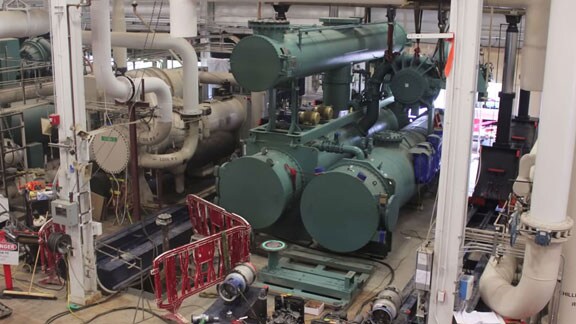Case Study: Chillers an Integral Part of a Hospital’s Resiliency
Houston Methodist Hospital Gains Reliable, Affordable Cooling Needs
Houston Methodist Hospital, a world-class hospital and medical research institution, requires a constant, reliable and affordable energy supply to meet its critical needs. That became even more obvious to administrators at Houston Methodist Hospital after Hurricane Katrina and other major storms from the following years. The hospital required the ability to create its own energy to maintain operations during the blackouts that can occur with major storms that regularly slam into the Texas gulf coast.
Challenges
The major expansion at the institution of a 1.1 million-square-foot (100,000 square meters), world-class research institute building spurred the hospital to upgrade its central utility plant (CUP). The successful, year-long CUP upgrade project reduced overall energy usage, costs and greenhouse gas emissions while providing the hospital with necessary resiliency.
Houston Methodist Hospital, the flagship of the Houston Methodist healthcare system, is a 1,000-bed facility that attends to nearly 40,000 inpatients and more than 300,000 outpatients each year. The private, non-profit hospital is consistently listed among U.S. News & World Report’s best hospitals in the country and most recently as the no. 1 hospital in the state of Texas. In addition to being a teaching hospital, Houston Methodist healthcare also operates a major medical research institute.
Solutions
For two decades, Johnson Controls and its YORK® brand chillers have played a major role in helping the hospital meet its very specific cooling needs by offering flexible and efficient solutions.
Bruce Flaniken, manager of FMS engineering services, facilities design & construction/network hospital construction departments, explained that the unnerving hurricane experiences and building expansion plans resulted in hospital administrators taking a hard look at the central plant. The CUP’s seven existing YORK® steam-driven and electric chillers had sufficient chilling capacity for the building expansion, but the cooling towers could not support the operation of all chillers simultaneously. The facility was also not able to provide all required standby power during an emergency, to achieve added resiliency.
Upgrades enable CUP to continue operations during emergencies
“We still had the memory of Katrina and another storm the following year on our minds,” Flaniken said. “During Katrina, we lost water pressure and almost had to shut down. The city had to hook up a fire truck to our CUP to pump water into it."
“We looked at the numbers and realized we could put the money into the central plant and not only handle the energy needed for the expansion, but also have the emergency power to continue to operate if the grid goes down.”
The CUP upgrade addressed present chilled water concerns by adding seven new cells to increase the cooling tower requirements. Houston Methodist Hospital replaced a 2,000-ton (7,000 kW) existing R-22 electric chiller with a high efficiency YORK® YST model 2,800-ton (9,800 kW) R-134a steam-driven chiller. The new chiller reduced electrical demand by 1,600 kW.
Next up was a high-pressure natural gas turbine generator combined heat and power (CHP) unit to produce 4.5 MW of power and thermal recovery via a combination heat recovery steam generator. The turbine generator (CHP) creates the steam required to run the YORK® YST chillers.
The CHP generator also meets the hospital’s steam demand for heating, sterilizing and hot water. It additionally helped shift the facility’s demand from the existing utility power grid to natural gas, resulting in major savings. For only the cost of running the condenser-chilled water pumps and cooling tower fans, the CUP can now produce up to 2,800 tons (9,800 kW) of chilled water from free steam and another 2,000 tons (7,000 kW) of chilled water from lower cost steam.
The CUP can also produce up to 8,800 tons (31,000 kW) of emergency cooling with the electric and steam-turbine YORK® chillers even if all power is lost due to rolling brownouts or storm-caused blackouts. The hospital can maintain operation of a major portion of the medical campus, including patient care and research demands while still reducing dependency on the local power grid.
“We are now the only hospital in the Texas Gulf Coast area that can operate during hurricane-type power grid outages,” Flaniken said.
Outcomes
Project payback twice as fast as expected
In just the first year, Houston Methodist Hospital experienced over $1.8 million in energy costs and savings continue each year. The project achieved payback almost twice as fast as expected, from four years to a little over two years. Another added benefit from the entire CUP revamp is a significant reduction in the greenhouse gases nitric oxide (NOX), sulfur dioxide (SO2) and carbon dioxide (CO2).
Contributing to the savings is the Metasys® building automation system from Johnson Controls. The BAS helped improve reliability, record keeping and maintenance of the CUP. In addition, Metasys offers optimization of all chillers, pumps, cooling towers, CHP electrical general and thermal energy recovery and high-pressure steam boilers integration.
“Integrating the Metasys and CHP system controls, installing the YORK® chiller, cooling tower and piping cross connections without shutting down the existing CUP utilities had to be carefully planned and migrated,” Flaniken said.
Building upon best practices
Flaniken said Johnson Controls and YORK® have long been important contributors to the success of the Houston Methodist Hospital. In 2004, the installation of a 2,000-ton (7,000 kW) YORK® steam turbine chiller was undertaken as part of an energy rebate from a local utility company, therefore paying for a portion of the unit.
“We had an old chiller that was giving us problems, so we opted to take the rebate and get a more technologically advanced efficient chiller to replace the old technology at the same time,” he said.
In 2013, Johnson Controls replaced the oldest 2,000-ton (7,000 kW) YORK® model Titan OM chiller with a 2,000-ton (7,000 kW) YORK® model YK chiller with a medium voltage variable speed drive to further improve efficiency to up to 30 percent, increase equipment longevity and reduce noise levels.
“We’re proud of what our team – and that includes Johnson Controls – has done to create a model central utility plant capable of meeting the needs of a modern, growing big-city hospital,” Flaniken said.

